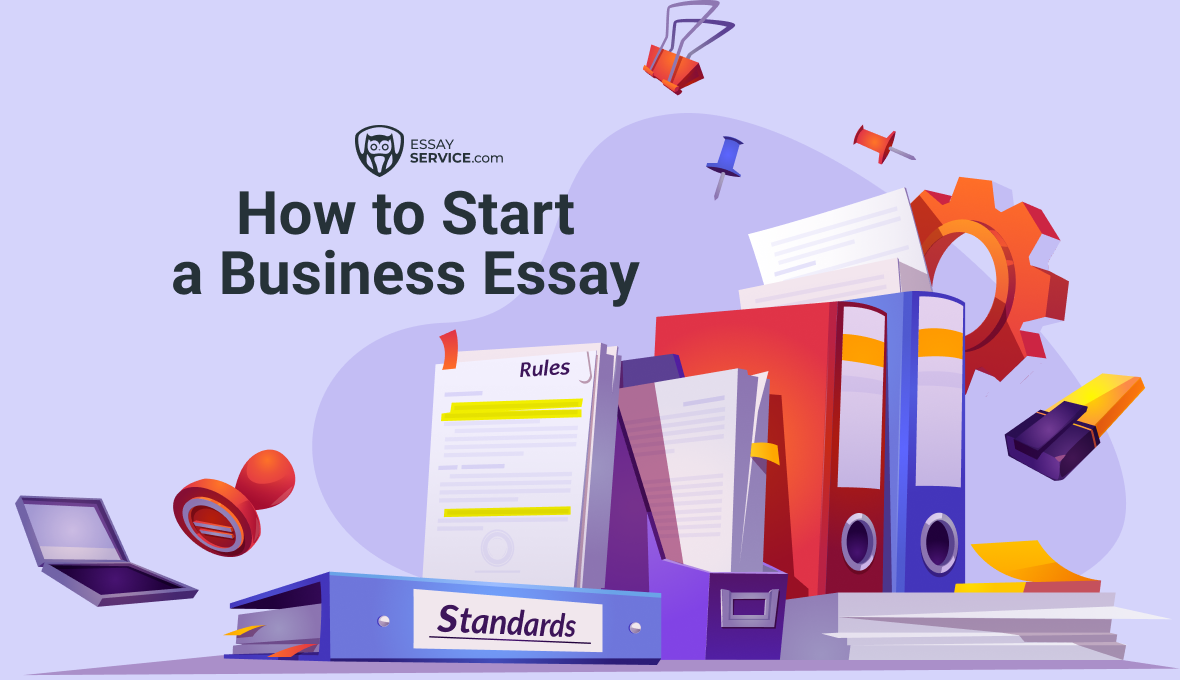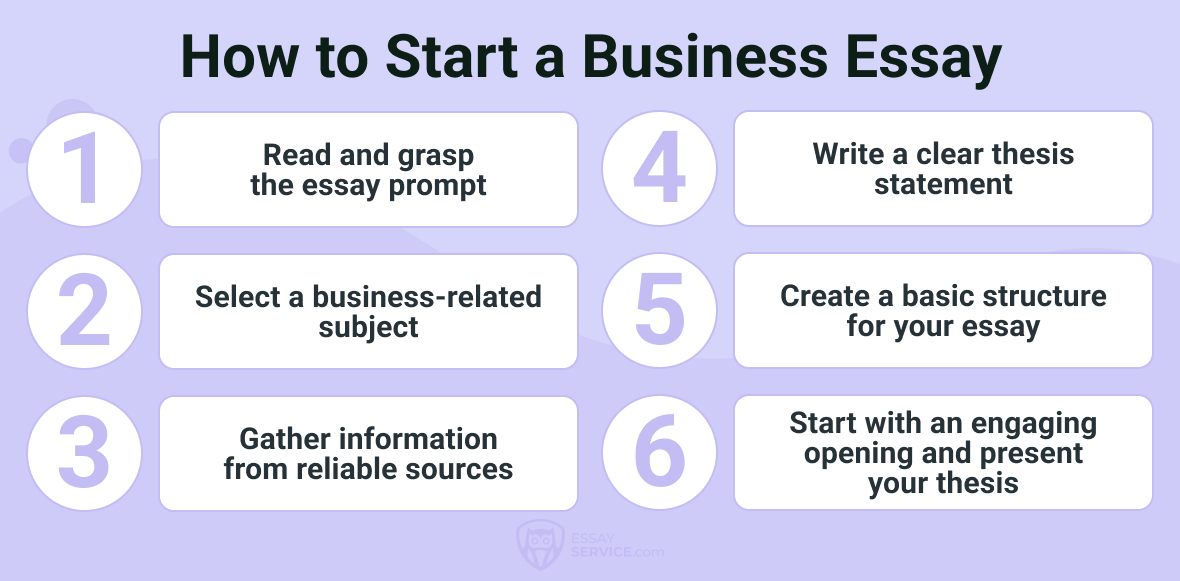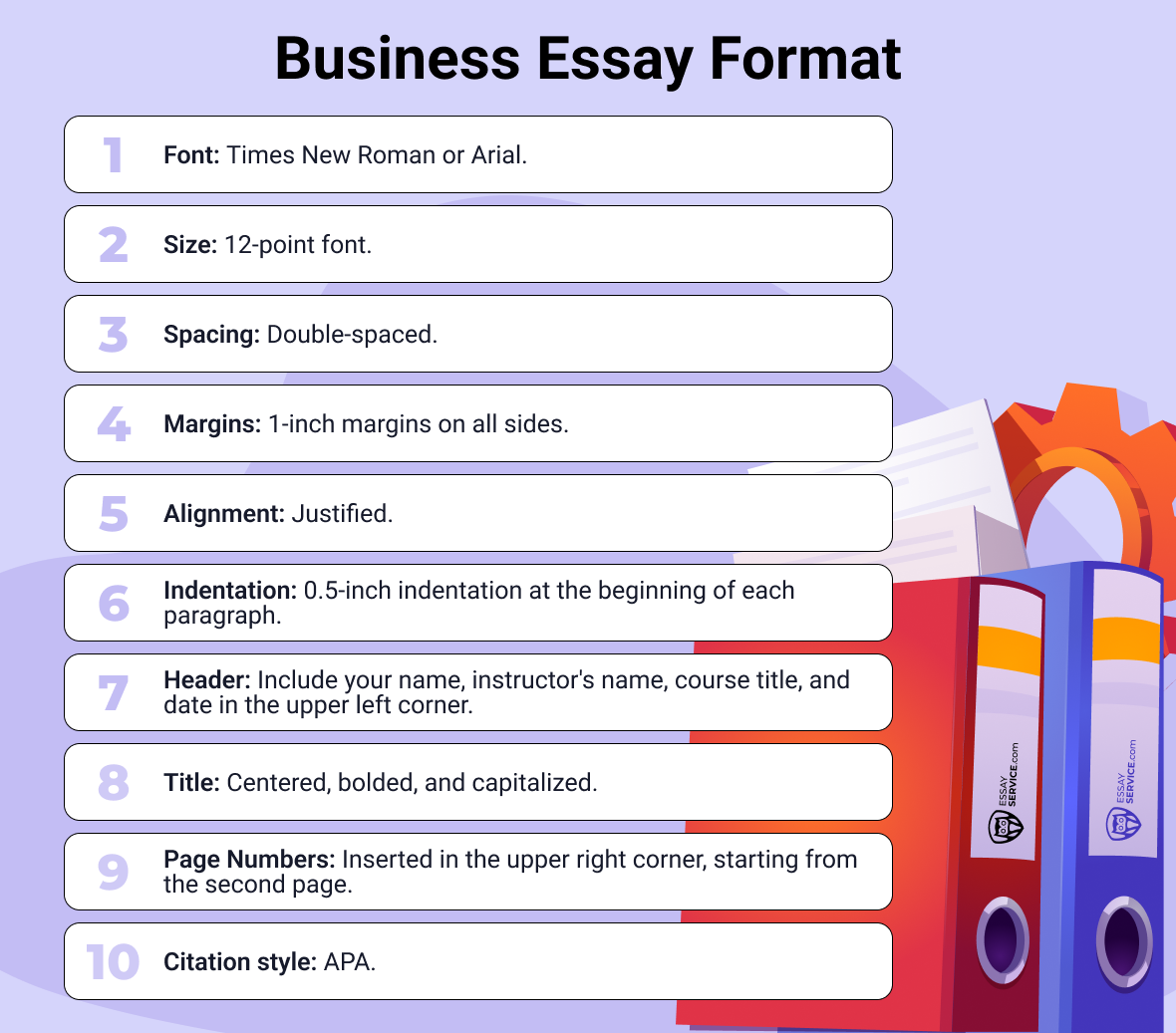
How to Start a Business Essay: Full Explanation with an Example
Starting a business is like setting off on a wild adventure. It's thrilling, full of ups and downs, and it's up to you where you want to go. But let's face it: it's also confusing! With so much to think about, it's easy to feel lost. That's where this essay comes in. We're here to break it all down for you, giving you the lowdown on turning your business dreams into a solid action plan. So, grab a cup of coffee and get ready to dive in!
What Is a Business Essay?
An essay on business is a written composition that explores various aspects of the business world, ranging from theoretical concepts to practical applications. Typically, it analyzes specific topics within the realm of business, such as management practices, marketing strategies, financial analysis, or entrepreneurship. Business essays often provide insights, arguments, and recommendations supported by research, data, and real-world examples. They aim to inform, persuade, or educate readers about key issues, trends, or challenges in the business environment, fostering a deeper understanding of the subject matter and stimulating critical thinking. Our business essay writing service supports such types of assignments, so if you need help – feel free to request a quote.
What Is a Startup Business Concept?
A startup business concept is essentially the seed from which an entire venture grows. The initial spark of inspiration sets the foundation for everything that follows. This concept typically arises from identifying a gap or inefficiency in the market or recognizing an unmet need or problem potential customers face. Entrepreneurs then conceptualize innovative solutions to address these challenges, whether a new product, service, or approach.
The concept defines the startup's unique value proposition, outlining what makes it stand out in a crowded marketplace. For example, a startup concept might involve developing a mobile app to streamline a tedious process, creating a sustainable alternative to an existing product, or offering a niche service tailored to a specific audience.
Once a startup concept is formulated, it undergoes refinement and validation through market research, feasibility studies, and prototyping. This stage involves gathering feedback from potential customers, testing assumptions, and assessing the concept's viability in the real world. Entrepreneurs analyze market trends, competitive landscape, and consumer preferences to fine-tune their concept and ensure it aligns with market demand.
Additionally, they evaluate the concept's scalability and potential for growth, considering factors such as market size, revenue potential, and scalability. Through this iterative process, the startup concept evolves into a robust business model that serves as the blueprint for the startup's operations, guiding decisions related to product development, marketing strategy, and resource allocation.

How to Start a Business Essay?
Starting a business involves several key steps. Firstly, it's essential to identify a viable business idea that aligns with your passion, expertise, and market demand. Research your target market, competitors, and industry trends to refine your concept. Once you have a solid idea, develop a comprehensive business plan outlining your goals, strategies, and financial projections. This plan will serve as a roadmap for your venture and help secure funding or investment.
Next, you'll need to choose a legal structure for your business, such as a sole proprietorship, partnership, corporation, or LLC. Register your business name and obtain any necessary licenses or permits. Set up your business finances, including opening a business bank account and obtaining any required insurance. Finally, develop a marketing strategy to promote your products or services and attract customers. Building a strong online presence, networking with other businesses, and utilizing social media can all be effective marketing tactics. With careful planning and execution, you'll be well on your way to launching a successful business. Now, let’s review a basic business essay outline:

Introduction
- Grab the reader's attention with an interesting fact, quote, or anecdote related to the topic.
- Provide context and background information on the topic.
- State the main argument or purpose of the essay.
Body Paragraphs
- Paragraph 1: Describe the current business landscape, including trends, challenges, and opportunities.
- Paragraph 2: Discuss the significance of developing a comprehensive business plan for startups and established businesses.
- Paragraph 3: Outline the essential components of a business plan, such as market analysis, competitive analysis, marketing strategy, operations plan, and financial projections.
- Paragraph 4: Explore different sources of funding available to entrepreneurs, including bootstrapping, loans, venture capital, and crowdfunding.
- Paragraph 5: Discuss effective marketing strategies for promoting products or services, building brand awareness, and attracting customers.
- Paragraph 6: Highlight the significance of delivering exceptional customer service and building strong relationships with customers.
- Paragraph 7: Emphasize the importance of adaptability and innovation in responding to market changes and staying competitive.
Conclusion
- Summarize the main argument or purpose of the essay.
- Review the main points discussed in the body paragraphs.
- Leave the reader with a thought-provoking idea, question, or call to action related to the topic.
Business Paper Format
The business essay format typically follows a structured outline, including the following sections:

Title Page
- This page includes the paper's title, your name, the name of your institution (if applicable), and the date.
Abstract
- A brief summary of the paper's main points, usually around 150-250 words, providing an overview of the topic, purpose, methodology (if applicable), and key findings or conclusions.
Introduction
- This section introduces the paper's topic, provides background information, and states the purpose or objective of the study.
Literature Review
- A review of relevant literature and research on the topic, highlighting existing theories, studies, and findings related to your research question or problem statement.
Methodology
- If applicable, this section outlines the research methods and techniques used to collect and analyze data, including any tools, procedures, or sampling techniques.
Results
- Presentation of the findings or results of your study, often including tables, charts, or graphs to illustrate data and statistics.
Discussion
- Interpretation and analysis of the results, discussing their significance, implications, limitations, and relevance to the research question or problem statement.
Conclusion
- A summary of the paper's main findings and key points, restating the purpose and significance of the study, and offering recommendations for future research or practical applications.
References
- A list of sources cited in the paper, formatted according to a specific citation style (e.g., APA, MLA, Chicago).
Appendices
- Optional supplementary materials include additional data tables, survey instruments, or detailed methodology descriptions.
How to Write an Introduction for a Business Essay?
Writing an introduction for a business essay requires capturing the reader's interest while setting the stage for the topic you'll be discussing. Here's a guide to crafting an effective introduction:
Start with a Hook
- Begin with an attention-grabbing opening sentence to pique the reader's curiosity.
- This could be a surprising fact, a compelling statistic, a thought-provoking question, or a relevant quote from a business leader or expert.
Provide Context
- After the hook, provide a brief overview of the topic you'll address in the essay.
- Give the reader some background information to understand the significance and relevance of the subject matter.
- Explain why the topic is important and matters in the business world.
State Your Thesis
- End the introduction with a clear and concise thesis statement that outlines your essay's main argument or purpose.
- This statement should provide a roadmap for what the reader can expect to learn or discover in the essay.
- Make sure your thesis is specific, debatable, and supported by evidence you'll present in the body paragraphs.
Transition to the Body
- Use the end of the introduction to transition smoothly into the essay's main body.
- Briefly preview the key points or arguments you'll discuss in the subsequent paragraphs to give the reader an idea of what's to come.
How to Write a Business Essay?
Let's kick things off with a solid step-by-step guide that sets the stage. We're about to dish out some awesome business essay writing tips to make your essay shine like a beacon in a sea of words. So, buckle up, grab your pen (or keyboard), and let's get started on crafting an introduction that'll hook your reader from the get-go!
Understand the Business Assignment
Take the time to carefully read and understand the assignment prompt or guidelines provided by your instructor. Pay attention to any specific requirements, such as the length of the essay, formatting style, or particular topics to address. If you have any questions or uncertainties about starting a business essay, don't hesitate to seek clarification from your instructor to ensure you're on the right track before you begin researching and writing.
Research and Gather Information
Start your research by consulting various credible sources relevant to your topic. Utilize academic journals, books, reputable websites, and industry reports to gather information and evidence to support your arguments. Take detailed notes while conducting your research, recording key ideas, quotes, statistics, and their corresponding sources. Keep track of your sources to facilitate proper citation later on. Consider how you will engage readers in the business essay introduction – an anecdote, interesting quote, or relevant statistics.
Outline Your Essay
Create an outline for your how to start a business essay to organize your thoughts and structure your essay. Begin by outlining the main sections of your essay, such as the introduction, body paragraphs, and conclusion. Within each section, outline the main points you want to cover and the supporting evidence you'll use to support your arguments. Consider the logical flow of information and how each section relates to the overall thesis of your essay. Your outline serves as a roadmap for writing your essay and helps maintain coherence and clarity.
Write the Essay
With your outline in hand, start drafting your essay. Begin with a strong introduction that provides context for your topic, grabs the reader's attention, and clearly states your thesis or main argument. In the body paragraphs, develop each main point outlined in your outline, providing evidence, examples, and analysis to support your arguments. Ensure you cite your sources accurately and consistently throughout the essay according to the chosen citation style. Conclude your essay by summarizing the main points discussed in the body paragraphs and reinforcing the significance of your thesis. Leave the reader with a memorable closing thought or call to action related to the topic.
Revise and Edit
After writing a business essay, take the time to revise and edit it thoroughly. Review your essay for clarity, coherence, and logical flow of ideas. Check for grammar, punctuation, spelling errors, and any inconsistencies or gaps in your argumentation. Consider your essay's overall structure and organization, making adjustments as needed to improve readability and coherence. Seek feedback from peers, tutors, or instructors to gain fresh perspectives and identify areas for improvement. Make revisions based on the feedback received, and refine your essay until you are satisfied with the final draft. Finally, proofread your essay one last time to ensure it meets all the requirements and is ready to be submitted.
Startup Business Ideas
- A meal prep delivery service.
- An online marketplace for handmade goods.
- Mobile car wash and detailing.
- Virtual tutoring platform.
- Dog walking app.
- Farm-to-table food delivery.
- Outdoor gear rental.
- Virtual event planning.
- Home repair matchmaking.
- Maternity wear rental.
- On-site beauty services.
- Freelance photography booking.
- DIY crafting workshops.
- Mobile bike repair.
- Sustainable flower delivery.
- Virtual fitness training.
- Plant-based meal kits.
- Urban parking rental.
- Houseplant subscription.
- Fresh produce delivery.
- Mobile car maintenance.
- Gift concierge service.
- Virtual cooking classes.
- Errand running assistance.
Business Essay Topics
- Social media marketing's impact on small businesses.
- Improving employee engagement strategies.
- E-commerce: Challenges and opportunities.
- Customer relationship management success.
- Sustainable business practices and benefits.
- The gig economy: Pros versus cons.
- Workplace diversity and inclusion.
- Technology's influence on operations.
- Managing remote teams effectively.
- Corporate social responsibility in ethics.
- Entrepreneurship: Challenges and successes.
- Globalization's impact on SMEs.
- Leadership in organizational change.
- Workplace wellness programs.
- Business ethics in the digital age.
- The power of branding: Identity creation.
- Crisis management strategies for resilience.
- Efficient and sustainable supply chain management.
- Future of work: Trends and implications.
- Business innovation: Creativity and adaptation.
- Financial management for small businesses.
- Data privacy and security.
- Effective time management strategies.
- Emotional intelligence in leadership.
- Company culture: Retention and satisfaction.
Do’s and Don’ts of Business Essay Writing
There are certain rules for writing a business essay that you must follow and particular don’t-do-this issues that you should avoid.
Do's:
- Clearly understand the essay prompt and adhere to any guidelines provided.
- Conduct thorough research using credible sources to support your arguments.
- Create a well-organized outline to structure your essay effectively.
- Craft a strong introduction that grabs the reader's attention and states your thesis clearly.
- Provide evidence and examples to support your arguments, using proper citations.
- Maintain a formal and professional tone throughout the essay.
- Use clear and concise language, avoiding jargon or overly complex terminology.
- Proofread your essay carefully to eliminate errors in grammar, punctuation, and spelling.
- Conclude your essay by summarizing key points and restating your thesis.
Don'ts:
- Don't plagiarize or use someone else's work without proper attribution.
- Avoid going off-topic or including irrelevant information in your essay.
- Don't rely solely on personal opinion; support your arguments with evidence and analysis.
- Avoid using informal language or slang in your writing.
- Don't rush through the writing process; take the time to revise and edit your essay thoroughly.
- Avoid making unsupported claims or assertions without evidence to back them up.
- Don't forget to cite your sources properly according to the chosen citation style.
- Avoid overloading your essay with too much information; focus on quality over quantity.
- Don't neglect the importance of formatting and presentation; ensure your essay is well-structured and visually appealing.
Business Essay Example
Here’s an example of a business essay that will be an excellent source of inspiration and formatting hints. If you want a new paper of similar quality, feel free to leave a quote.
Summary
Business essays serve as invaluable learning tools for students, providing them with a platform to apply theoretical concepts to real-world scenarios and develop essential skills for success in the business world. Students hone their critical thinking, problem-solving, and communication abilities by learning how to set up an essay, research topics, analyze facts, and write eloquently about various business topics. Business essays also encourage students to stay updated on current trends and developments in the business landscape, fostering a deeper understanding of industry dynamics and challenges. Moreover, writing business essays cultivates students' ability to formulate well-reasoned arguments, articulate their ideas effectively, and present information in a structured and persuasive manner, all of which are crucial competencies in professional settings.
Frequently asked questions
How to Write a Business Essay?
First, thoroughly understand the essay prompt or assignment guidelines provided by your instructor. Conduct extensive research using credible sources to gather relevant information and evidence to support your arguments. Develop a clear thesis statement that outlines your essay's main argument or purpose. Create a well-organized outline to structure your essay, dividing it into sections such as introduction, body paragraphs, and conclusion. In the body paragraphs, present your arguments logically and support them with evidence, analysis, and examples. Use clear and concise language, avoiding jargon or overly complex terminology. Finally, conclude your essay by summarizing the main points and restating your thesis, leaving the reader with a strong final impression.
How to Write an Introduction for a Business Essay?
A compelling introduction for a business essay is essential to engage the reader and set the stage for the rest of the essay. Start with a hook that grabs the reader's attention, such as an interesting fact, statistic, quote, or anecdote related to the topic. Provide context and background information to help the reader understand the topic's significance. Clearly state your thesis or main argument, outlining what you will discuss in the essay. Keep the introduction concise but informative, giving the reader a preview of what to expect in the subsequent paragraphs.
How Many Paragraphs Does a Business Essay Have?
A business essay typically consists of several paragraphs (1,000 to 2,500 words), each serving a specific purpose to communicate the ideas and arguments presented effectively. The exact number of paragraphs may vary depending on the length and complexity of the essay, as well as the specific requirements of the assignment. However, a standard business essay often includes an introduction, several body paragraphs, and a conclusion.
New posts to your inbox!
Your submission has been received!




